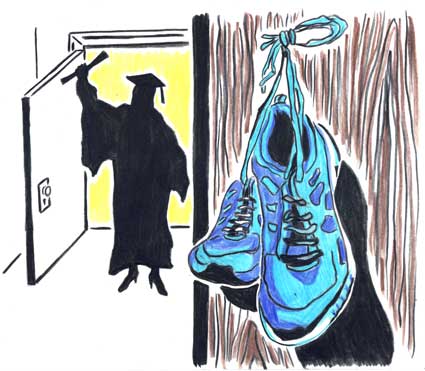The staff editorial is the majority opinion of The Murray State News Editorial Board.

Kiara Austin recently walked into a meeting with her track and field coaches as a “student-athlete” and walked out just a student.
Despite the odds, Austin is a first-generation college student graduating in May.
Approximately a third of undergraduate students are first-generation college students, according to a 2012 National Postsecondary Student Aid Study. Of those students, only about 40 percent complete a degree in six years.
Instead of being rewarded for her hard work and determination to be one of the 40 percent, she ended up facing a tough decision: whether she would compete in the track and field OVC championships or walk across the stage at commencement.
Austin first approached her coaches with her desire to attend the commencement ceremony last May. She confirmed her decision to walk across the stage in August. After a meeting with her coaches in late October, Austin signed disassociation papers, stripping her of her athlete and scholarship privileges.
A menial 2 percent of high school athletes are awarded athletic scholarships to compete in college, according to a 2014 NCAA study. Furthermore, approximately two-thirds of students have to borrow money to pay for college and graduate owing, on average, more than $25,000, according to The Hechinger Report.
In choosing the honor to walk at her graduation, Austin is sacrificing rare scholarship money and is potentially risking going into debt.
Allen Ward, Murray State director of athletics, said she was presented with “attractive alternatives.” How attractive could those other options have been if she chose to stop competing altogether for a chance to fully participate in the first college graduation ceremony in her family?
Austin is a proud student with a lot going for her, but also a lot going against her – Murray State athletics should not have become the latter.
What is the proper order? Student-athlete or athlete-student?
Sixty percent of college athletes consider themselves “more as athletes than students,” according to an NCAA study. Austin is not alone.
A trophy should not outweigh a degree.
Yes, Austin signed a contract with Murray State athletics which outlined their expectations and requirements. That contract, however, should not mean she signed away her right to be a student as well.
The fact that Austin felt compelled, whether or not athletics directly forced her, to choose the lesser of two evils is an injustice to both the system of higher education and to Austin’s self-worth.
Austin is ranked No. 2 in Murray State’s history in track and field jumps. Does her value at Murray State end there? Absolutely not.
Student-athletes are required to do well in school and obtain a certain GPA, so why the disconnect now? Why does the academic support and encouragement end because of an inconvenient scheduling conflict? Why is it an either-or choice and why are the consequences so severe?
If a student is passionate about and excels at both academics and athletics, they shouldn’t be forced – directly or indirectly – to choose between the two.





























































































